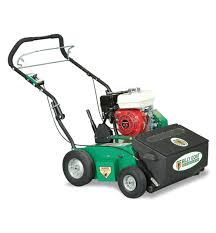 Did you know you can use your Billy Goat overseeder to lay down fertilizer? If you have an OS500, OS801 or a PR550 with the overseeder conversion kit, it can drop granular fertilizer the same way it drops seed. This can save you money on equipment costs and gives you more options for application. Here’s how you can put your overseeder to work spreading fertilizer.
Did you know you can use your Billy Goat overseeder to lay down fertilizer? If you have an OS500, OS801 or a PR550 with the overseeder conversion kit, it can drop granular fertilizer the same way it drops seed. This can save you money on equipment costs and gives you more options for application. Here’s how you can put your overseeder to work spreading fertilizer.
Why Granular Fertilizer?
Using your overseeder, you can distribute fertilizer uniformly over the turf to get the best results, and you can spread the grains over a wider area than a manual drop spreader, decreasing job times. Granular fertilizer is more expensive than liquid fertilizer, but by using your overseeder for seeding and fertilizing, you can save a lot of money on equipment. Granular fertilizers also give you more options for nutrient release.
Selecting a Fertilizer
The best fertilizer is the one that best matches the needs of your lawn based on a tested soil sample. However, even if you know exactly what nutrients you need, there are some choices you need to make to get the best results.
The fertilizer bag will have “NPK” numbers printed on it. These represent the percentage of the three main components in fertilizers:
N – Nitrogen improves leaf development and makes grass look greener.
P – Phosphorous helps root growth.
K – Potassium helps root growth and disease resistance.
For example, 16-4-8 is 16% nitrogen, 4% phosphorous and 8% potassium. These numbers should match what is recommended on your soil test.
Some blends are aimed at different seasons. Winterizer fertilizer has added potassium to help grass deal with stress during the winter, while starter fertilizers have extra phosphorus to kick start the growth of new grass. “Weed and feed” fertilizers combine fertilizer with pre-emergent herbicides to stop broadleaf growth in the spring.
Quick Release or “water-soluble nitrogen” (WSN) fertilizer goes to work immediately and last up to a month depending on rainfall. This is great for giving a newly seeded lawn a boost, increasing growth to push out weeds. Slow Release or “water-insoluble nitrogen” (WIN) blends are less likely to cause fertilizer burn, and they won’t wash away as easily if it rains.
Spreader Calibration
An accurate drop rate is critical for even fertilizer coverage. Drop rates vary slightly between spreaders, even if they’re identical models, and even different applications can vary due to factors like machine speed. Measuring the actual drop rate of your machine will help you get the right setting to deposit fertilizer evenly.
To check the drop rate, you’ll need a few tools:
A tape measure.
A scale that measures in either ounces or grams. A postal scale is ideal for this purpose.
A bucket
Flags or lawn chalk
A calculator
1. Measure and mark off a 50 or 100-foot length of turf.
2. Carefully measure out 5 or 10 pounds of fertilizer and add it to the hopper.
3. Set the drop rate to the amount recommended on the packaging.
4. Move the seeder a few feet behind the marked strip. Get it moving, then close the drop lever as soon as the hopper reaches the marked strip. If you have an OS500, you can line it up at the start of the strip and use the automatic hopper system to start fertilizing immediately. Fertilize the strip.
5. Shut off the machine and empty the hopper into the bucket. Measure the weight of the remaining fertilizer. The difference between the starting and ending weight is the amount of fertilizer you used.
Multiply the length of your overseeder’s hopper by the length of fertilized ground. For example, if you have an OS500 with a seedbox that’s 26.5 inches (approximately 2.2 feet) wide on a 100-foot strip of turf, you just covered 220 square feet. Divide 43,560, the number of square feet in an acre, by the number of square feet you just covered. Multiply the resulting number, in this case, 198, by the amount of fertilizer you used, and you’ll get the drop rate per acre. You may need to go up or down one setting on the hopper to get the drop rate to match up with the recommended coverage.
Getting Even Growth
For the best results, split the job into two passes running criss-cross to each other, going left to right over the yard, then up and down. This masks any overlapped or skipped areas, giving the lawn a more even appearance and avoiding problems with burned patches. Remember that you need to drop half the recommended fertilizer for each pass.
Need Something for Your Billy Goat?
If you need something to fix your equipment, or you want to turn your PR-series power rake into an overseeder, visit www.billygoatparts.com. We’re a certified dealer for Billy Goat and Honda Engines, so we’re able to ship OEM accessories and replacement parts to any location in the United States or Canada. Finding the right part is easy: just pick your model and serial number, and our site will show you parts listings and diagrams specific to your equipment.
